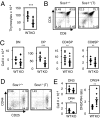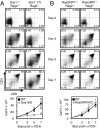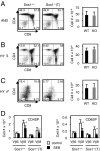Targeted Sos1 deletion reveals its critical role in early T-cell development
- PMID: 21746917
- PMCID: PMC3145744
- DOI: 10.1073/pnas.1104295108
Targeted Sos1 deletion reveals its critical role in early T-cell development
Abstract
Activation of the small G protein Ras is required for thymocyte differentiation. In thymocytes, Ras is activated by the Ras guanine exchange factors (RasGEFs) Sos1, Sos2, and RasGRP1. We report the development of a floxed allele of sos1 to assess the role of Sos1 during thymocyte development. Sos1 was required for pre-T-cell receptor (pre-TCR)- but not TCR-stimulated developmental signals. Sos1 deletion led to a partial block at the DN-to-DP transition. Sos1-deficient thymocytes showed reduced pre-TCR-stimulated proliferation, differentiation, and ERK phosphorylation. In contrast, TCR-stimulated positive selection, and negative selection under strong stimulatory conditions, remained intact in Sos1-deficient mice. Comparison of RasGEF expression at different developmental stages showed that relative to Sos2 and RasGRP1, Sos1 is most abundant in DN thymocytes, but least abundant in DP thymocytes. These data reveal that Sos1 is uniquely positioned to affect signal transduction early in thymocyte development.
Conflict of interest statement
The authors declare no conflict of interest.
Figures





Similar articles
-
Deconstructing Ras signaling in the thymus.Mol Cell Biol. 2012 Jul;32(14):2748-59. doi: 10.1128/MCB.00317-12. Epub 2012 May 14. Mol Cell Biol. 2012. PMID: 22586275 Free PMC article.
-
Sos1 regulates sustained TCR-mediated Erk activation.Eur J Immunol. 2014 May;44(5):1535-40. doi: 10.1002/eji.201344046. Epub 2014 Feb 20. Eur J Immunol. 2014. PMID: 24497027 Clinical Trial.
-
The ability of Sos1 to oligomerize the adaptor protein LAT is separable from its guanine nucleotide exchange activity in vivo.Sci Signal. 2013 Nov 12;6(301):ra99. doi: 10.1126/scisignal.2004494. Sci Signal. 2013. PMID: 24222714 Free PMC article.
-
Ras and extracellular signal-regulated kinase signaling in thymocytes and T cells.Trends Immunol. 2013 Jun;34(6):259-68. doi: 10.1016/j.it.2013.02.004. Epub 2013 Mar 15. Trends Immunol. 2013. PMID: 23506953 Free PMC article. Review.
-
SOS2 Comes to the Fore: Differential Functionalities in Physiology and Pathology.Int J Mol Sci. 2021 Jun 21;22(12):6613. doi: 10.3390/ijms22126613. Int J Mol Sci. 2021. PMID: 34205562 Free PMC article. Review.
Cited by
-
Unique dependence on Sos1 in Kras G12D -induced leukemogenesis.Blood. 2018 Dec 13;132(24):2575-2579. doi: 10.1182/blood-2018-09-874107. Epub 2018 Oct 30. Blood. 2018. PMID: 30377195 Free PMC article.
-
Cutting Edge: Induced Loss of Rasgrp1 in Peripheral CD4+ T Cells of Conditional Rasgrp1-Deficient Mice Reveals an Essential Role for Rasgrp1 in TCR/CD28-Induced Ras-MAPK Signaling.J Immunol. 2023 Sep 15;211(6):917-922. doi: 10.4049/jimmunol.2300138. J Immunol. 2023. PMID: 37566514 Free PMC article.
-
Regulation of ras exchange factors and cellular localization of ras activation by lipid messengers in T cells.Front Immunol. 2013 Sep 4;4:239. doi: 10.3389/fimmu.2013.00239. Front Immunol. 2013. PMID: 24027568 Free PMC article. Review.
-
Mechanism of SOS PR-domain autoinhibition revealed by single-molecule assays on native protein from lysate.Nat Commun. 2017 Apr 28;8:15061. doi: 10.1038/ncomms15061. Nat Commun. 2017. PMID: 28452363 Free PMC article.
-
Structural analysis of autoinhibition in the Ras-specific exchange factor RasGRP1.Elife. 2013 Jul 30;2:e00813. doi: 10.7554/eLife.00813. Elife. 2013. PMID: 23908768 Free PMC article.
References
-
- Buday L, Downward J. Many faces of Ras activation. Biochim Biophys Acta. 2008;1786:178–187. - PubMed
-
- Hanahan D, Weinberg RA. The hallmarks of cancer. Cell. 2000;100:57–70. - PubMed
-
- Mor A, Philips MR. Compartmentalized Ras/MAPK signaling. Annu Rev Immunol. 2006;24:771–800. - PubMed
-
- Daniels MA, et al. Thymic selection threshold defined by compartmentalization of Ras/MAPK signalling. Nature. 2006;444:724–729. - PubMed
Publication types
MeSH terms
Substances
Grants and funding
LinkOut - more resources
Full Text Sources
Molecular Biology Databases
Miscellaneous

